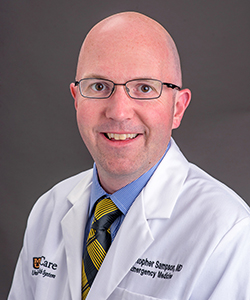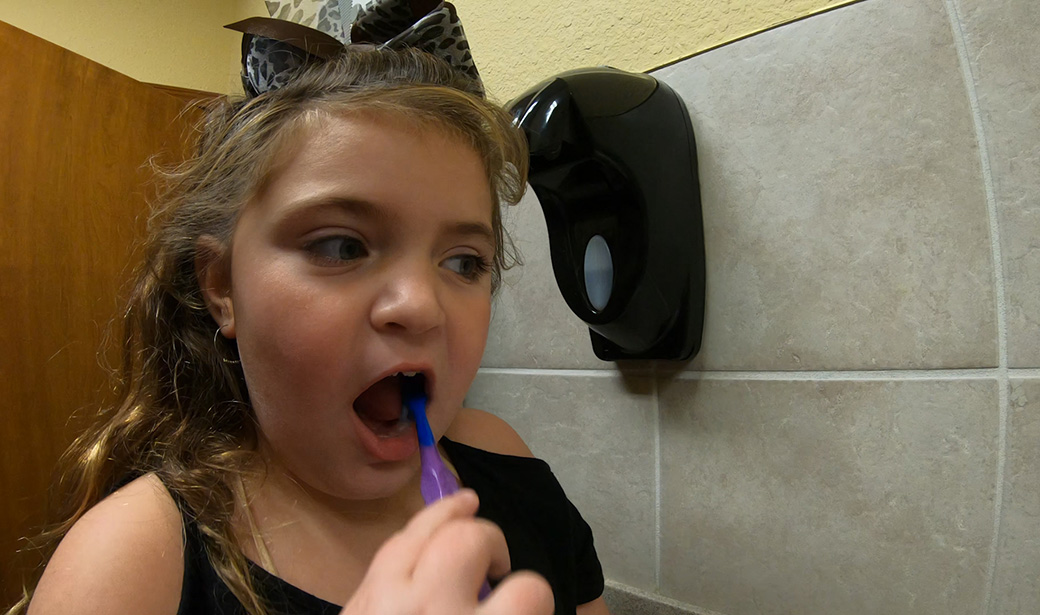Reese White is just like any other second-grade girl. She loves Barbies, swimming and playing with her friends in Versailles, Missouri. As the youngest of David and Kelley White’s four children, Reese is the only one in the household who isn’t tall enough to look at herself in the mirror above the bathroom sink.
But there’s one mirror in the house on Reese’s level — the full-length looking glass attached to the back of her parents’ bathroom door. Kelley and David never imagined that mirror placement could have endangered their daughter. But after an incident on March 18, 2018, they’ll think twice before opening their bathroom door without knocking first.
“It was totally a freak accident,” Kelley said. “I felt awful. It was horrible.”
Reese was getting ready for bed and used the mirror on the back of her parent’s door to help her brush her teeth. Kelley quickly opened the door into Reese, knocking the toothbrush through her mouth and into her throat.
“She didn’t start screaming or freaking out right away,” Kelley said. “She just went into my son’s room, and I heard him say, ‘Oh, my God, what’s wrong with her? She’s bleeding!’ I ran into the room, and there was just blood everywhere.”
When Kelley looked into her daughter’s throat, she couldn’t see anything but blood and knew Reese needed medical attention immediately. Kelley and David put Reese in the car and drove 45 minutes from Versailles to a hospital in Jefferson City.
“I drive to Jefferson City every day for work,” David said. “And that was the fastest I’ve ever gotten there.”
When the White’s arrived, a doctor examined Reese and gave the parents some sobering news —Reese had a puncture wound in the back of her throat and the injury might be serious because of its proximity to the carotid artery that supplies blood to the brain. Any damage to that vessel could cause a life-threatening hemorrhage.
“That’s when we realized it was serious, and we got really scared,” Kelley said.

Reese was transferred by ambulance to MU Health Care’s University Hospital, mid-Missouri’s only Level I trauma center. Christopher Sampson, MD, treated Reese when she arrived.
“We needed to see Reese’s blood vessels and make sure they weren’t damaged,” Sampson said. “We injected dye into her blood through an IV and used a CT scan to locate her vessels. Thankfully, it was a small puncture wound. She didn’t have a severe injury to her blood vessels, so it didn’t need to go to the operating room or require stitches.”
After consulting with an ear, nose and throat specialist, Sampson allowed Reese to go home.
“We’ve seen a fair number of severe toothbrush injuries,” Sampson said. “One case a few years ago required surgery to remove an impaled toothbrush from the back of a young child’s throat. Reese was definitely lucky.”
The Whites considered Reese’s injury a “freak accident,” but Sampson has seen enough of them that he wondered how common these cases are nationwide. He researched toothbrush injuries from 2006-16 and published his findings in the American Journal of Emergency Medicine earlier this year.
He discovered 257 toothbrush incidents in the National Electronic Injury Surveillance System (NEISS) database. Based on the sample size, the NEISS database estimated there are more than 850 toothbrush injuries in the U.S. each year.
“We found most of those injured by toothbrushes were 4 years old and younger,” Sampson said. “A majority were seen in the emergency department and then discharged. But we found a significant number of cases that required sutures or surgery.”
Toothbrush packages contain a warning label recommending adult supervision for children 3 and younger.
“Parents should make sure young children don’t wander away from the sink while brushing,” he said. “There are always risks if you are walking around or running with a toothbrush in your mouth. Just stand by the sink and focus on the job you’re doing.”
David and Kelley White were surprised how quickly Reese’s injury healed. They are happy to have this ordeal behind them and thankful their youngest is back to normal and enjoying the perks of being Kelley’s “mini-me.”
“My co-workers didn’t think it was a big deal until I showed them pictures,” David said. “We went through a lot, but it was the best outcome possible.”



